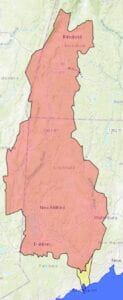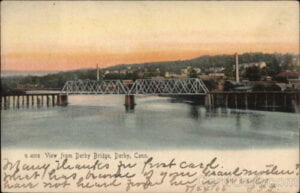Thinking With a River: Housatonic Valley History and Culture
Edited by Sheila Liming and Jacob A.C. Remes
Abstracts due February 1, 2023Deadline extended to March 31, 2023

What might it do to our understanding of American history and culture to take watersheds as units of scholarly analysis, naturally defined regions that should be studied together? Thinking With a River: Housatonic Valley History and Culture will explore this question in the context of the Housatonic River, which drains a watershed of nearly 2,000 square miles in Western Massachusetts, Western Connecticut, and Eastern New York. We seek submissions from scholars in any discipline or field who explore the culture and history of the region, putting into conversation scholarship of the various writers, artists, and intellectuals who lived or spent time in the Berkshires (and the Litchfield Hills) with labor and environmental histories of industry in Pittsfield, Danbury, and the Naugatuck Valley, which is part of the same river system. We want to examine seriously the idea of rivers and their drainage basins as units of analysis, and thus solicit papers about the literary and artistic histories of the region, environmental studies, Indigenous studies, labor history, and other topics. How do our understandings of these disparate topics change when we put them together?
The goal of this edited volume is twofold. First, it seeks to be useful to students, scholars, and activists who want to understand the Housatonic Valley, its people, its history, and its influence. Second, it serves as a case study of fluvial thinking: in privileging the study of a place over the specifics of a given population, the volume privileges diverse forms of social history and seeks to escape the pitfalls of populational siloes.
We are interested in any topic from any humanistic or social scientific discipline that involves the Housatonic Valley in any time period. We are especially eager to receive abstracts on the following topics:
- Environmental history and environmental studies perspectives on the river and its drainage basin, including PCB and mercury pollution, damming and the decline of anadromous fish, or other topics.
- The Indigenous peoples, past and present, of the Housatonic Valley, including, among others, the Mohican, Munsee Lenape, Wappinger, Paugussett, Stockbridge-Munsee, Pootatuck, Weantinock, and Schaghticoke peoples.
- Labor history of the various industries of the Housatonic, including iron, brass, paper, arms, clocks and watches, hats, rubber, hydroelectricity, tourism, and agriculture.
- Deindustrialization and economic transition in any era—ranging from changes in agriculture in the 18th and 19th centuries and the decline of the Salisbury iron industry, to the deindustrialization of Pittsfield and the Naugatuck Valley—including its social, cultural, political, and environmental aspects and questions of what comes after economic transitions.
- Architecture and urban design in the Housatonic Valley, including adaptive reuse of agricultural and industrial space.
- Religious, political, and social movements that have been active in the region and organizers, activists, and others with close ties to the region, for instance Jonathan Edwards (Stockbridge, Mass.), Mum Bett Freeman (Sheffield, Mass.), John Brown (Torrington, Conn.), Mary Parsons (Lenox, Mass.), and W.E.B. Du Bois (Great Barrington, Mass.); political spaces like Camp Unity (Wingdale, N.Y.); and events like the Amenia (N.Y.) Conferences of 1916 and 1933 and the Sharon (Conn.) Statement of 1960.
- Literary, artistic, and musical movements associated with the region, or artists or writers who lived in or are associated with the region, including authors like Herman Melville (Pittsfield, Mass.), Mark Twain (Tyringham, Mass.), Edith Wharton (Lenox, Mass.), singer Marian Anderson (Danbury, Conn.), composer Charles Ives (Danbury, Conn.), painters Jasper Johns (Sharon, Conn.) and Norman Rockwell (Lee, Mass.), and landscape designer Beatrix Farrand (Stockbridge, Mass.), among others.
- Popular culture inspired by or associated with the region, for instance Arlo Guthrie’s song “Alice’s Restaurant” or Amy Sherman-Palladino’s television series “Gilmore Girls.”
The University of Massachusetts Press has expressed interest in publishing the volume. The editors are currently raising money to support a workshop in the Berkshires; if we are successful in raising funds, we will invite all the authors to come to workshop each other’s papers to prepare them for publication.

We seek contributions from scholars in any field, and we particularly encourage independent scholars and journalists to propose chapters. While most of the book will be scholarly chapters, we are also open to artistic contributions.
Please submit abstracts of approximately 300 words, along with a CV, to jacob.remes@nyu.edu by February 1, 2023. Abstracts should explain not only the specific topic of the proposed paper but how it will connect and contribute to a joint understanding of the Housatonic Valley.
Editors:
Sheila Liming is associate professor of communication and creative media at Champlain College in Burlington, Vermont. A scholar of Edith Wharton, she is the author of What a Library Means to a Woman: Edith Wharton and the Will to Collect Books (University of Minnesota Press, 2020), Office (Bloomsbury, 2020), and Hanging Out: The Radical Power of Killing Time (Melville House, 2023). Her writing has appeared in the Los Angeles Review of Books, The Atlantic, Lapham’s Quarterly, Public Books, The Point, The Chronicle Review, and elsewhere.
Jacob Remes is clinical associate professor of history at New York University’s Gallatin School of Individualized Study. Trained as a labor and working-class historian of North America, he is the author of Disaster Citizenship: Survivors, Solidarity, and Power in the Progressive Era (University of Illinois Press, 2016) and the editor, with Andy Horowitz, of Critical Disaster Studies (University of Pennsylvania Press, 2021). He has written for Time, The Atlantic, Alternet, and The Nation, and he is the co-editor, with Scott Knowles and Kim Fortun, of the University of Pennsylvania Press book series Critical Studies in Risk and Disaster. He serves on the board of the Sharon (Connecticut) Historical Society and Museum.

Leave a Reply